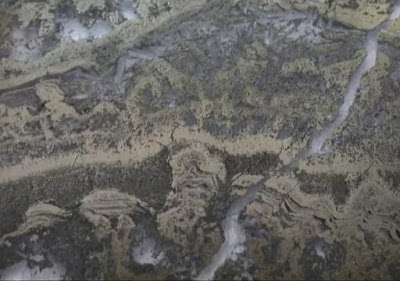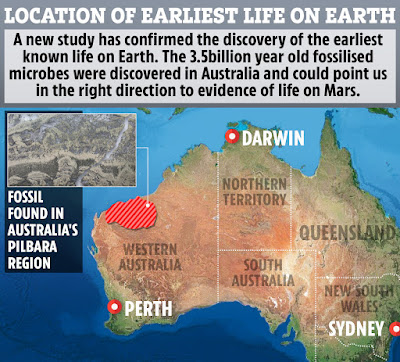 | Western Australia's 3.5-billion-year-old stromatolites push back the earliest known existence of microbial life on land by 580 million years.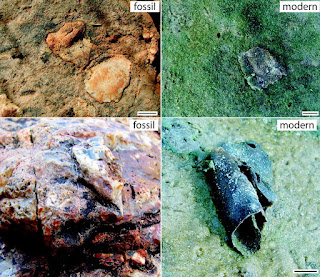 |
Thursday, September 26, 2019
Scientists find microbial remains in ancient Pilbara rocks
Monday, September 23, 2019
Asteroid collision triggered ancient ice age
 | Scientists claim a massive asteroid collision may have filled the atmosphere with enough dust to trigger an ice age. They say sunlight-blocking dust remained in the sky for around two million years, effectively causing Earth to freeze. Scientists have long been puzzled by the cause of an ice age that took place 466 million years ago. Dust is constantly floating down to Earth from space, made from broken parts of asteroids and comets. Scientists believe Earth gains about 40,000 tons of extraterrestrial material every year. Through dating mechanisms, it's possible to verify that a large amount of dust fell around the same time as an ice age began. Not all sunlight would have been blocked – but enough to change Earth's climate. This allowed life to adapt "and even benefit" from the changes, sparking "an explosion of new species". |
Sunday, September 22, 2019
Crocodiles revered in ancient Egypt
| Several thousand years ago, an Egyptian mummy supplier crept up on a wild crocodile and bashed it with a club, fracturing its skull and killing it. The animal was processed. Its damaged skull was fixed. Its body was treated with salts, oil and resins, and wrapped in multiple layers of linen. Its last meal was still in its stomach. The demand for mummified crocodiles was intense in ancient Egypt. Thousands were bred and reared in captivity to be expertly mummified for offerings to the gods. In addition to people, millions of dogs, cats, foxes, gazelles, baboons, monkeys, horses, lions, goats, even shrews were expertly preserved. Animal mummies were produced in mass quantities mostly as “votives” to make requests of the gods. |
Saturday, September 21, 2019
Gold mask, bronze helmets of Macedonian warriors found
 | Archaeologists in Greece have uncovered a gold mask and bronze helmets from a cemetery at Ahlada, near the town of Florina in Northern Greece. The finds came from the graves of elite warriors who died in the 6th century B.C. Despite being plundered in antiquity the graves still contained treasures. |
 | Artifacts included the face mask, made specially for funerals, four bronze helmets, iron spearheads and fragmented iron swords, a large bronze urn with ornate handles, an iron model of a farm cart and bronze leg armor. (grieves) More than 1300 graves have been found. |  |
Thursday, September 19, 2019
Ancient Sites without the tourists
 | Ruins are often the centerpieces of a trip overseas. Unfortunately everybody thinks the same: Stonehenge, Chichen Itza, the Great Pyramids, Pompeii. Take a less beaten path however and the ruins can be both spectacular and without any crowds. The Valley of the Temples in Agrigento is an archaeological site in Agrigento (ancient Greek Akragas), Sicily. It is one of the most outstanding examples of ancient art and architecture in the world. |
| La Ciudad Perdida. Magdalena, Colombia. Reached only after a grueling five-day trek through the Colombian jungle, it’s almost 1,000 years older than Machu Piccu. It was abandoned after the Spanish conquest and only rediscovered in the 1970s. |  |
 | Acrocorinth. Corinth, Greece. Acrocorinth, or Upper Corinth has sheep roaming among the ruins, not tourists. Acrocorinth was continuously occupied from archaic times to the early 19th century. |
| Ruins of Jerash. Jerash, Jordan. The most intact Roman city outside of Italy, Jerash was a crossroads of many cultures. The city flourished until the mid-eighth century CE, when the 749 Galilee earthquake destroyed most of it. The ancient city has been gradually revealed through a series of excavations. |  |
The First Circulating Coins
 Ionia, Circa 650-600 BC. Hekte (one-sixth stater) Ionia, Circa 650-600 BC. Hekte (one-sixth stater) | Little is known about this electrum (natural alloy of gold and silver) coin. It was minted in Ionia, somewhere in central Western Anatolia on the shores of the Aegean, but the precise city-state that produced it is unknown. It could have been minted in Miletus, a city often referred to as the origin of the modern world. This type likely represents the first true coins which circulated in everyday use. This type are small 1/24th staters which represented about a day’s pay. Larger denominations are rare. Even fewer trites (one-third stater) are known, and only three full-size staters have ever been found. |
| During the excavation of the Temple of Artemis at Ephesus (present day Turkey near the Black Sea), a group of coins was found which are thought to be its 'foundation deposit', a custom that supposedly prevented the building from falling into ruin. The largest type in the group, a stater, had an inscription stating, 'I am the badge of Phanes'. It's meaning has been lost to antiquity. Coins revolutionized commerce, offering an accessible, neutral medium through which transactions could be processed quickly and fairly. | 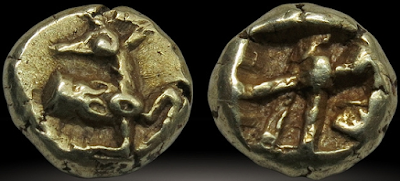 |
Wednesday, September 18, 2019
Scottish gold ring found by metal detectorist brings £17k
 | Dating from the 17th century, the ring was discovered by a novice metal detectorist on the shores of Loch Lomond. Before the sale, experts managed to discover the ring’s history. The crest belonged to the Colman family of Brent Eleigh, Suffolk, who made their fortune in the mid 16th century from the cloth trade. It's thought to have belonged to Edward Colman, who became an ardent convert to Catholicism. The inside of the ring bares an engraved “I” for Jesus, a personal symbol that could indicate that the owner was a member of the Jesuits, an undercover society of Catholics which was illegal in England at that time. In September 1678, Jesuits were accused of involvement in plots to assassinate the king and restore Charles II. Edward was listed as a plotter. He was found guilty of treason and hung, drawn and quartered. Considered to be a Catholic martyr, he was beatified by the Pope in 1929. |  |
Tuesday, September 17, 2019
Ancient Humans interbred with Neanderthals
 Neanderthal child | In 1997, scientists found the first scrap of Neanderthal DNA in a fossil. Since then, they have recovered genetic material, even entire genomes, from a number of Neanderthal bones. Their investigations have yielded a surprise: Today, 1 to 2 percent of the DNA in non-African people comes from Neanderthals. That genetic legacy is the result of interbreeding roughly 50,000 years ago between Neanderthals and the common ancestors of Europeans and Asians. Recent studies suggest that Neanderthal genes even influence human health today. |  |
 | The DNA extracted in 1997 was from the original specimen of Neanderthals, found in the Neander valley near Dusseldorf, Germany. It suggested that the Neanderthal lineage is four times older than the human lineage, meaning that Neanderthals split off much earlier from the hominid line than did humans. Humans and Neanderthals split from a common ancestor in Africa some 600,000 years ago. At some point afterward, the ancestors of Neanderthals spread to Europe, the Middle East and Central Asia. Along the way, Neanderthals took on a distinctive anatomy — a stocky, powerful build — and became impressive hunters. |  |
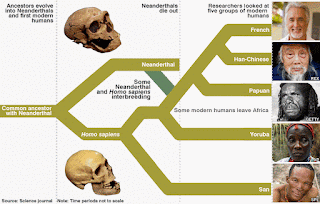 | Now scientists have found that the genes flowed both ways. In a study published in Nature, a team of scientists reported that another instance of interbreeding left Neanderthals in Siberia with chunks of human DNA. In 2010 scientists recovered about 60 percent of a Neanderthal genome from fossils found in a Croatian cave. |  |
 A toe bone from a male Neanderthal dating back at least 50,000 years. | Neanderthals shared certain mutations with living Europeans and Asians, but not with modern Africans. They concluded that humans must have interbred with Neanderthals after leaving Africa. Three years later the complete genome of a male Neanderthal was recovered from a toe bone dating back at least 50,000 years, which had been discovered in the Altai Mountains of Siberia. Comparing the Altai genome to modern human DNA confirmed the interbreeding. |  |
Monday, September 16, 2019
Ingot find reveals UK’s ancient trade routes
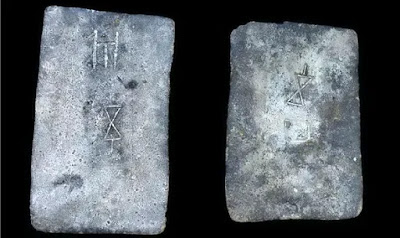 Similar ingots, dating from around 1,300 BC, were also found at archaeological sites in Greece and Turkey. Similar ingots, dating from around 1,300 BC, were also found at archaeological sites in Greece and Turkey. | New evidence suggests Britain had trade routes with the rest of the world as far back as the Bronze Age. Researchers have revealed 3000-year-old tin ingots found in Israel actually originated from Devon and Cornwall. |  |
 | Commodities such as tin, amber and glass were highly prized in the ancient world and were the catalysts of international trade routes. The origin of tin has long been an enigma in archaeological research. Bronze was used to make weapons, jewellery, and daily objects. Tin ingots are valuable for research because they can accurately point to their exact origin. Around 3,000 BC, ancients began smelting copper with tin in order to create a stronger metal; bronze. The Bronze Age witnessed the development of many innovations. Societies around the world grew faster and more advanced and trade was the reason. |
Saturday, September 14, 2019
Aureus of Hadrian - 67k
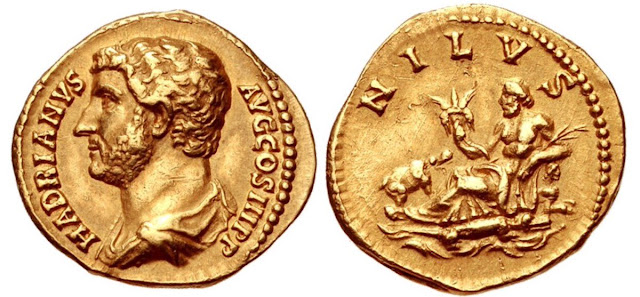 | A gold aureus of Hadrian (A.D. 117 to 138). The reverse shows the river god Nilus reclining, half draped, with one arm supporting his weight on a sphinx and the other holding a cornucopia. Part of Hadrian’s famed “Travel Series” where he celebrated his travels including an extended visit to Egypt in 130 to 131. |
Friday, September 13, 2019
Ancient Nubia Now
 | Between 2400 BCE and 300 CE, a series of kingdoms flourished in what is today the Sudanese Nile Valley. Nubian kings and queens controlled vast empires and trade networks yet are forgotten to history. “Ancient Nubia Now” features more than 400 items, many never before exhibited.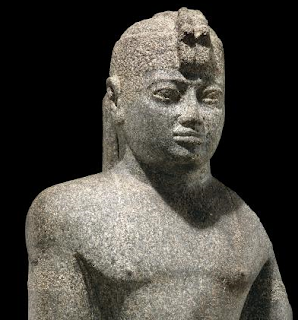 |
 | Among the highlights are the jewels of Nubia’s queens, the statue of Senkamanisken from the sacred mountain of Gebel Barkal, the army of funerary figurines from the tomb of King Taharqa, the gold and silver treasure of King Aspelta, and the stele of King Tanyidamani. |
 |  |
Wednesday, September 11, 2019
Burgess Shale yields first spiders/scorpions
 | Burgess Shale have yielded another ground-breaking fossil find. This time its the oldest known ancestor of today’s spiders and scorpions. |
| Mollisonia plenovenatrix is over 500 million years old. It had large eyes to spot prey. Long limbs propelled it across the sediments. Its head was like a modern multi-tool with limbs that could sense, grasp, crush and chew. The tiny pair of structures in front of its mouth are the same pincers on all members of the family Chelicerata. That’s 115,000 different species, and here is the one that started it all. See ----->Theft from Burgess Shale |  |
Tuesday, September 10, 2019
Poodle from Hell
Sunday, September 8, 2019
Gold from Ancient Panama - The Coclé
 | For more than a thousand years, a cemetery on the banks of the Rio Grande Coclé in Panama lay undisturbed, escaping the attention of gold seekers and looters. The river flooded in 1927, scattering beads of gold along its banks. In 1940, a Penn Museum team led by archaeologist J. Alden Mason excavated at the cemetery, unearthing spectacular finds.  | 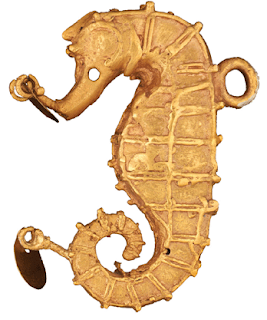 |
 Human effigy pendant of gold, copper, silver alloy, Sitio Conte, Panama, ca. 700-900CE. | Large golden plaques and pendants with animal-human motifs were found, precious and semi-precious stone, ivory, and animal bone ornaments, and literally tons of detail-rich painted ceramics. It was extraordinary evidence of a sophisticated Precolumbian people, the Coclé, who lived, died, and painstakingly buried their dead long ago.  |   |
 | Long overshadowed by research on other indigenous Central and South American peoples, the Coclé, who lived from about 700 to 900 CE, remain mysterious. |  |
 |   |  |
Subscribe to:
Comments (Atom)

